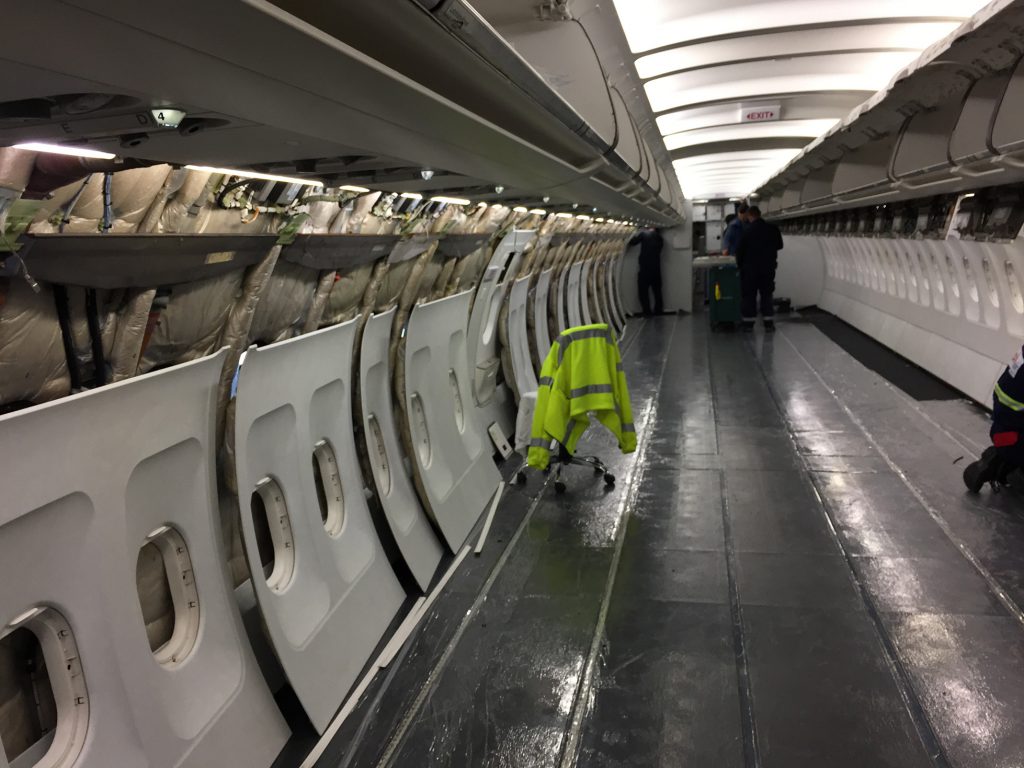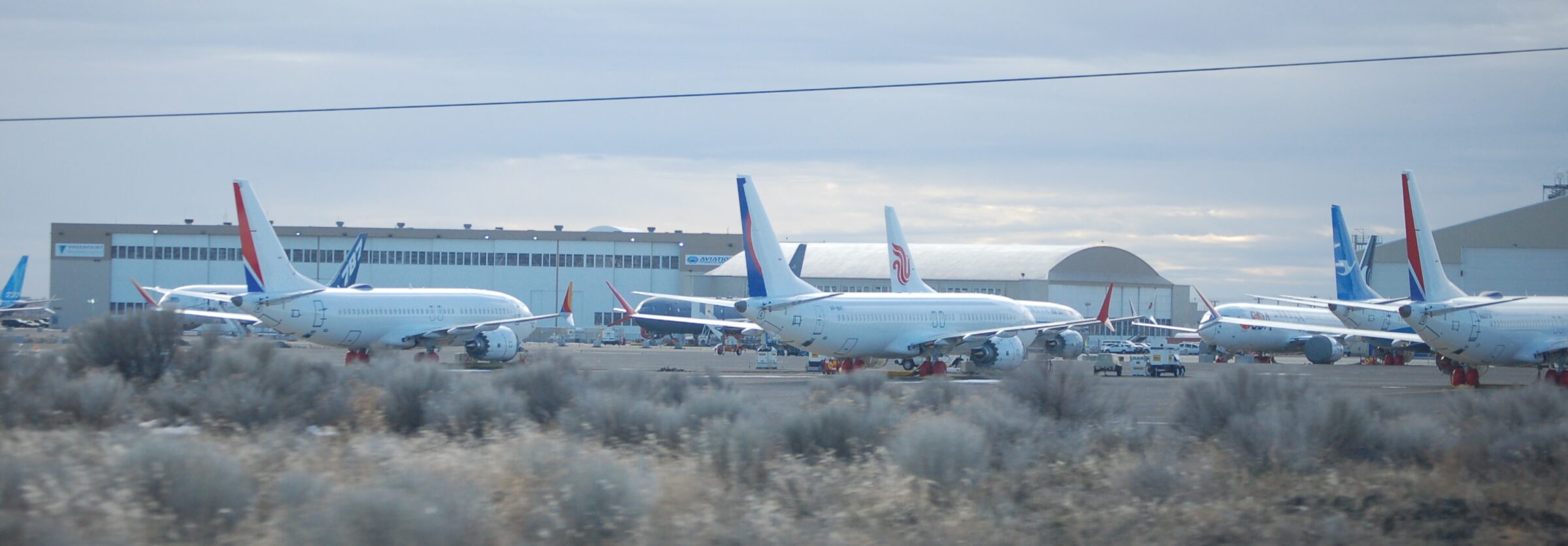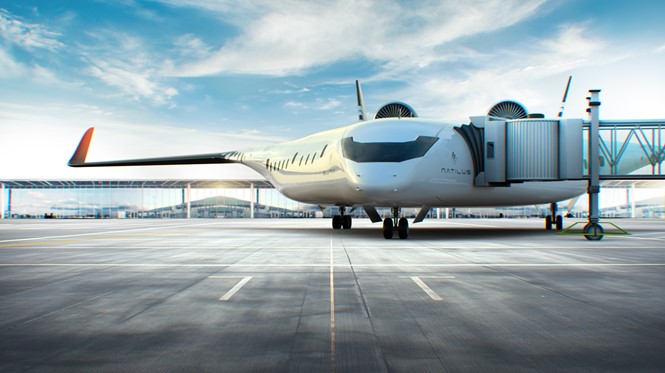Leeham News and Analysis
There's more to real news than a news release.
Does an A220-500 need a new wing and engines? Part 2.
Subscription required
By Bjorn Fehrm
May 5, 2025, © Leeham News: We started the articles series about stretching the A220 to a capacity in the A320neo range last week by going through the development of the A220-100 and -300, how it’s designed and compares to the competition in the 100 to 140 seat segment.
Now, we analyze what we need to change to bring the capacity to the level of the A320neo and whether changes to the wing and engines, in addition to prolonging the fuselage, are necessary when we increase its capacity.
We use the Leeham Aircraft Performance and Cost Model (APCM) to look at the design data for the A220-300 and discuss what it will mean to make the different changes.
Summary:
- The A220-300 has field and range performance that matches an A320neo.
- As we increase the length of the A220 fuselage to match the seating capacity of the A320neo, we run into tricky trade situations regarding range and field performance for an A220-500.
JetZero readies effort for private equity fund raising
Subscription Required
By Scott Hamilton
May 5, 2025, © Leeham News: JetZero, the start-up company developing commercial aviation’s first passenger Blended Wing Body (BWB) airplane, is gearing up to seek private equity funding for billions of dollars needed to bring its aircraft to market.

JetZero president and COO Dan da Silva demonstrates the human scale of the Z4 Blended Wing Body mock-up at the company’s Long Beach (CA) facility. Credit: Leeham News.
In a media day on Friday, executives and staff briefed reporters on progress to date, production work on the first full-size demonstrator aircraft, technical details and studies continuing an production plans.
Officials expect to announce a site selection for its final assembly plant in the coming weeks, before the Paris Air Show that begins in mid-June.
JetZero’s airliner is dubbed the Z4. It’s nominally a 250-passenger, 5,000nm design for the so-called Middle of the Market currently occupied by out-of-production and aging Boeing 767-300ERs, Airbus A330-200s and a limited number of Boeing 757s. Entry-into-service is targeted for the “early 2030s.” The first flight of the demonstrator aircraft is planned for 2027.
JetZero has an ambitious goal for producing the composite aircraft. The final assembly site, for which the company has down-selected the finalists, will be on a 1,000 acre site with a building about the size of Boeing’s widebody plant in Everett (WA). Boeing’s Everett site is somewhat larger than 1,000 acres.
JetZero is planning for a monthly production rate of 20 five years after production begins. The company has hundreds of conditional orders from major airlines.
Daunting tasks remain in the coming years. Among them: there is currently no engine commitment for the airplane; a product support system is needed; finalizing the method to product the composite airplane; “flying” the iron bird; and much more.
Boeing wants to remarket China’s airplanes. It’s costly and time consuming.
- China has 130 Boeing airplanes that are identified in the Boeing backlog. On last week’s earnings call, officials said China accounts for 10% of its backlog of 6,319 aircraft as of March 31. This means there are about 500 Chinese-destined aircraft in the “Unidentified” backlog.
- Reconfiguring airplanes would cost millions of dollars. Backlogs to order materials and complete the work could be as much as two years. Engineering that may be required and regulatory review also could take a year or two.
Subscription Required
By Scott Hamilton

Reconfiguring aircraft interiors is a costly and time-consuming challenge. Aftermarket company ATS is one of those engaged in this sector. It explains the process here. Credit: ATS.
April 28, 2025, © Leeham News: China used to be Boeing’s most important single collective customer. By the end of 2016, this country’s airlines and lessors accounted for between 25% and 33% of Boeing’s annual deliveries, depending on the year.
Boeing was losing ground to Airbus there. The European rival aggressively sought to partner with China. In 2008, the company opened an A320 family final assembly line in Tianjin. This followed a long courtship in which Airbus boosted its supply chain and engineering in China. Airbus establishing an A330 finishing center in China in 2017.
In China, doing business there meant providing “benefit” to its new and growing industries. “Benefit” was a loosely defined term that generally meant transferring technology, helping create a supply chain and ordering parts and components made in China. For some, it meant providing kickbacks. (This is not suggesting Airbus engaged in kickbacks, but corruption is a matter of public record. Such was suggested to me when I was doing business in China between 1989 and 1993.)
It had been a long struggle. When Airbus was establishing its presence there selling airplanes, some officials said they didn’t need any air buses—passengers boarded by jet bridges. Over time, Airbus began to surpass Boeing’s orders in China and today is the leader.
Boeing recognized it needed to do more in China. It floated the idea of establishing a 737 final assembly line in China, but its touch-labor union, the IAM 751 exercised its veto contract clause to stop the idea. Instead, Boeing opened a 737 completion center in China in 2018.
Completion centers paint the airplanes and install the interiors. A few 737s were at Boeing’s completion center when President Trump started the tariff war with China; the airplanes returned to the United States.
How good is the C929? Part 2.
Subscription required
By Bjorn Fehrm
April 24, 2025, © Leeham News: We started looking at the future COMAC C929 widebody 10 days ago. The C929 development has gone through a number of challenges, the first being how to structure the cooperation between China’s COMAC and Russia’s United Aircraft, with the latest being what engines to use for the aircraft.
The first problem was solved by COMAC deciding to go it alone, whereas the last problem around engines has no definite solution yet.
Summary:
- The C929 airframe is taking form with detailed design having started, according to COMAC.
- The engine side is less settled. The likely engine is the Chinese CJ-2000, a 78,000lbf development of the CJ-1000A engine aimed at the C919.
- We apply the CJ-2000’s likely performance to the C929 airframe and use our Aircraft Performance and Cost Model (APCM) to predict the C929’s operational performance.
Hopes for 1Q financial progress turns into bumpy ride for Boeing
Subscription Required
By Karl Sinclair

At its peak, there were 140 Boeing 737 MAXes stored across Washington state destined for China. The number is now around 40, and with the tariff war, there is no telling when these will be delivered. Photo in March 2023 in Moses Lake (WA) by Scott Hamilton.
April 21, 2025, © Leeham News: Just when it looked like The Boeing Company (BA) had a sensible recovery plan and leadership that understood the tasks at hand, along came that pocket of turbulent air, which upset a smooth flight.
Boeing announces its 1Q2025 financial numbers on Wednesday. What had been hoped to be a positive report is now overshadowed by the impact of worldwide tariffs, announced by President Donald Trump on April 2.
The latest industry news, which seems to change daily, is that the Trump Administration has levied a 245% tariff on China, after China had retaliated against tariffs of 145%. Last week, Beijing reportedly told its airlines to refuse delivery of all Boeing products.
In the interim, Trump walked back exorbitant tariff rates applied to nearly 100 nations, calculated with a flawed theory, focusing instead on hitting China hard and retaining a blanket 10% rate on the rest of the world.
There was a further retreat as tariffs on electronics were removed on iPhones and tablets, as pressures in the bond market forced a move.
Nothing in the aviation industry operates in a vacuum, as corporations begin to circle the wagons.
Delta Air Lines will refuse to take any Airbus aircraft that are tariffed, according to CEO Ed Bastian. Ryanair’s CEO Michael O’Leary said the same, regarding Boeing aircraft.
Howmet Aerospace, a Tier 1 supplier, is preparing to use “force majeure,” a legal term referring to an unexpected event which prevents a party from fulfilling contractual obligations, to get out of delivering parts.
According to equity research firm Bernstein, other suppliers are expected to invoke the clause as needed.
This is only 17 days after Trump’s much-heralded “Liberation Day.”
Natilus: Composite BWB, entry-into-service by 2029, 570 on order
Subscription Required
By Karl Sinclair
April 17, 2025, © Leeham News: California-based Natilus is on target to begin delivering its first aircraft for service in 2029, a Blended Wing Body (BWB) turboprop cargo aircraft, according to CEO Aleksey Matyushev.
The pusher-type cargo aircraft Kona will soon be followed by a larger turbofan passenger version, the Horizon, in the early 2030s.
Matyushev, an aeronautical engineer previously the lead aerodynamicist at Piper Aircraft, sat down with LNA to discuss timelines, aircraft production, engineering challenges, and the powerplant options that Natilus will use.
Boeing welcomes COMAC competition as Asia-Pacific demand soars
Subscription Required
By Leeham News Team
April 15, 2025, © Leeham News: Boeing sees long-term growth potential in the Asia-Pacific commercial market, but the company also acknowledges that China’s domestically produced COMAC C919 poses a credible challenge in the single-aisle segment—particularly in China and potentially in the broader region over time.
With China’s state-backed aerospace ambitions gaining momentum, the U.S. manufacturer faces a new challenge threatening to unbalance the traditional duopoly with Airbus.
According to Boeing’s 2024 Commercial Market Outlook (CMO), Southeast Asia will require more than 4,700 new aircraft over the next 20 years. About 80% of this demand will be for single-aisle aircraft—a space Boeing would ordinarily seek to dominate with its 737 MAX family.
COMAC may still have work to do to gain credibility for the C919 inside and outside China, but its short-medium-range airliner is proving popular in its domestic market (Air China, China Eastern Airlines, and China Southern Airlines are current operators). The planemaker is now seeking customers elsewhere in the region, including Indonesia, Cambodia, and Kazakhstan. How potential U.S. tariffs will alter airline customer decision-making between Boeing and its rivals remains to be seen.
Speaking to LNA as the Routes Asia forum got underway, Dave Schulte, managing director of Boeing Commercial Marketing for Northeast Asia, Southeast Asia, and Oceania, said he welcomed the contest for supremacy.
“Competition is always good for the aviation industry,” Schulte said when asked about the impact of COMAC on Boeing’s plans in the region. “It makes everyone in the industry invest in better technologies and find solutions to meet evolving customer needs.
“In the future, airlines will need to make longer-term fleet decisions that support growth and profitability, while providing competitive fares and service levels to the public.
“To achieve this goal, airlines across the region and globally evaluate airplanes based on performance capabilities, comfort level for passengers, economics, and more.” Read more
How good is the C929?
Subscription required
By Bjorn Fehrm
April 14, 2025, © Leeham News: The COMAC C919 is finding its first customers outside China. At the same time as COMAC has started work on shorter and longer versions of the C919, work on a widebody C929 has been going on for the last 14 years.
If the development of more family members for the single aisle C919 is straightforward, the widebody C929 development has presented several challenges.
Summary:
- The C929 has been in development since 2011.
- The project was first delayed by Russia-China relations and recently by increasing tensions between China and the West.
- The latest problems are around the engines, as Western engines have become politically impossible.
Read more
Uncertainty plagues airline, aerospace, lessor industries over tariffs
Subscription Required
By Scott Hamilton
April 10, 2025, © Leeham News, Seattle: The airline and aerospace industries are plagued by uncertainty over the global tariffs announced by US President Donald Trump on April 2. The 90-day pause on nearly all tariffs announced yesterday doesn’t resolve the uncertainties. For the moment, they are only postponed.
Airframe and engine manufacturers, suppliers of components feeding them, and Buyer Furnished Equipment (BFE) directly to the airlines, lessors, aftermarket maintenance companies, and freighter conversion firms have many questions and no answers in chaos following Trump’s global tariff scheme.
Related Stories
Consider the unknowns:
- Will Trump tax the entire value of airplanes, engines, and components imported into the United States or just the foreign content? There is no guidance yet.
- Will other jurisdictions, notably the European Union, announce reciprocal tariffs? This is unknown because the Trump Administration hasn’t clarified what will be taxed.
- How will aircraft leased by non-US lessors be treated when US airlines are the customers? How will US lessors leasing to non-US airlines be treated? No answers.
- Contracts between lessors, airlines, Boeing, and Airbus don’t specifically address tariffs. Some airlines say they won’t pay tariffs because the contracts are silent. However, Boeing thinks there is a way to pass tariffs along. Airbus probably does, too.
- Over the last weekend, US-based supplier Howmet informed its customers it reserves the right to exercise the force majeure clause in its contracts to give it flexibility to suspend deliveries because of the tariffs. Other suppliers, including some engine companies, are following suit.
- At least one supplier has already billed some customers for delivered goods, including a tariff tax line item on the invoice.
- How will various jurisdictions treat aircraft converted into freighters with a mix of US and foreign content? There is no answer.
The US-based law firm Vedder Price issued its opinion and guidance on Tuesday on some issues.





